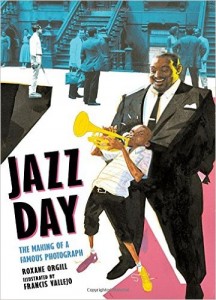2018 School Spending Survey Report
"Jazz Day": Roxane Orgill's Harlem Snapshots
In her most recent book, Roxane Orgill tells the story Art Kane's iconic photograph, Harlem, 1958, through a series of poems.
 In 1958, Art Kane, a graphic designer in New York City, “had a crazy idea.” He wanted to assemble as many musicians as he could and take a photograph of them for Esquire magazine's “Golden Age of Jazz” supplement. Esquire signed on, and word went out to the music community. Until everyone converged on 126th Street at the appointed time, Kane wasn’t sure how many people would show up. The photo taken on August 12 of that year, Harlem 1958, included 57 musicians “Standing on a stoop/Spilling on the sidewalk”—as well as 12 children who didn’t want to miss out on the fun. In her book Jazz Day (Candlewick, Mar. 2016; Gr 5 Up), Roxane Orgill tells the story of that day, the artists, and the iconic photo (a gatefold in the book) through a series of poems. Paintings by Francis Vallejo add detail, humor, and their own rhythm. You are known for your prose, not poetry. Can you talk about why you chose poetry to tell this story? I didn’t so much choose poetry as it happened. I looked at the photograph Harlem 1958 for a long time, I reviewed the documentary and examined the book that accompanied it, and I wondered how to tell a story. I tried a young picture book story (fictional, based on facts), straightforward nonfiction for older kids, and even a novel, briefly. Then a poem popped out. I’ve never written poetry, although my nonfiction has tended to be on the lyrical side. This sort-of poem, about the photographer, Art Kane, arriving on 126th Street and wondering if anybody would show up, eventually became “Early.” Poetry allowed me to pinpoint events, such as the bassist Milt Hinton greeting his friends and taking his own pictures, but also to go beyond the scene, as when I wrote how Duke Ellington wasn’t there because he was working in Milwaukee. I could be specific, I could evoke a musical style, I could swing into tangents (like Lester Young fashioning a porkpie hat), I could play—in poetry. Most important, I could dispense with a straightforward narrative and write about the subjects that grabbed me and leave out anything that didn’t. According to your author’s note, Art Kane was himself a bit of a storyteller. What sort of research went into getting the facts straight on this story? I found two sources particularly helpful. One was a book called Art Kane: The Persuasive Image, part of a series called "Masters of Contemporary Photography" written for photographers. It begins, “Until this book, Art Kane has been an enigma.” I’m sure he continued to be enigmatic after this book was published, in 1975, but he was interviewed extensively for it. Besides including many of his images, the book had a technical section that no other source had, so I learned what cameras he used, for instance. I was able to talk to one of his sons, Jonathan Kane, who told me, among other things, about the “copycat” photos that I list in the back of Jazz Day. Harlem 1958 has been much imitated! And I listened to the music. I couldn’t write about Willie “the Lion” or Luckey Roberts without getting familiar with their different styles of stride piano. There's a real mood of geniality in the photo, friends catching up with friends. How long did the photo shoot take? The shoot took several hours, from 10 a.m. to 2 p.m., more or less, and, of course, the musicians didn’t all arrive at 10:00 on the dot. Kane said he had to do a lot of yelling. He was reportedly surprised when he saw the contact prints, thinking to himself, “They look like real pictures!” There were 120 exposures from which to choose one for Esquire. The poems in Jazz Day serve as a snapshot of the event and the 1950s jazz community. What was it important for you to capture in your picture(s)? It was important to capture the ebullient mood of the day and the sense of risk by Kane (an amateur taking a flier on a big assignment from an important magazine). And I wanted the poems to have music in them, because without the music going on offstage, so to speak, the photo never would have happened; there would have been no “famous jazz photo.” It’s clear there were a number of side stories to the day, some of which you mention in your poems and notes (who walked out of the picture at the last minute, who found it tough to get up in the morning after playing the night before, etc.). Are there some you can share that you weren’t able to include? I would have liked to have written a poem about Marian McPartland, who’s wearing a stunning halter dress (like Marilyn Monroe’s in the famous subway-grate photo) and who I'd admired not just for her piano playing but her wonderful speaking voice and the easy but deeply engaged style she brought to her long-running radio show, Piano Jazz. She was playing at the Hickory House at the time, a big place on 52nd Street with sawdust on the floor. But nothing worked, the poem didn’t happen. I love how Francis Vallejo imagines some of those side stories in his art: musicians grouped around Maxine Sullivan, who you note “they miss”; Willie “the Lion” Smith sitting on the stoop next door; and neighborhood kids wishing everyone would go away so they could have their block back. Vallejo’s impressionistic paintings are so energetic and warm—much as I imagine the gathering was for those who made it there. When did you first see the images? I saw the art in several stages and was asked each time to offer comments or corrections as I saw them. In one illustration, for example, Leroy was wearing long pants, and I’d written “Leroy in short pants” in the accompanying poem. Leroy is one of two boys whose name we know—he is the child in the middle wearing a striped sweater, and short pants because he wasn’t old enough to graduate to long pants, a rite of puberty and a tradition from the 19th century on. It mattered to boys how long their pants were then, and it mattered to me. Fortunately, Francis was willing to shorten the trousers. For me, as the writer, looking at the illustrations during the book-making process always raises these kinds of questions. Even though this text is poems, it is nonfiction in the sense that it is fact-based, and I did a lot of research so the poems would be “true.” I want the art to be true also, but the artist may have other, equally legitimate concerns. It's probably unfair to ask, but do you have favorites among this group of musicians? And are there particular artists or pieces of music that you think are good to start with when introducing kids to jazz? I’m partial to Lester Young’s tenor playing, and that’s why I gave him a poem. I love Basie’s spare, clean style of piano playing, tunes like “One O’Clock Jump.” I think Dizzy Gillespie would be fun for kids to start with, because he was so amusing, a true showman, with his onstage antics and puffed-out cheeks, in addition to being an exciting trumpet player. These 57 people represent only a portion of jazz. Among the missing were Miles Davis and Louis Armstrong and Ella Fitzgerald, to mention only three “greats” of the era! What I like about the photograph is it represents a day in jazz, a serendipitous moment, the kind of moment that happens continually in the music. I think Art Kane got that.
In 1958, Art Kane, a graphic designer in New York City, “had a crazy idea.” He wanted to assemble as many musicians as he could and take a photograph of them for Esquire magazine's “Golden Age of Jazz” supplement. Esquire signed on, and word went out to the music community. Until everyone converged on 126th Street at the appointed time, Kane wasn’t sure how many people would show up. The photo taken on August 12 of that year, Harlem 1958, included 57 musicians “Standing on a stoop/Spilling on the sidewalk”—as well as 12 children who didn’t want to miss out on the fun. In her book Jazz Day (Candlewick, Mar. 2016; Gr 5 Up), Roxane Orgill tells the story of that day, the artists, and the iconic photo (a gatefold in the book) through a series of poems. Paintings by Francis Vallejo add detail, humor, and their own rhythm. You are known for your prose, not poetry. Can you talk about why you chose poetry to tell this story? I didn’t so much choose poetry as it happened. I looked at the photograph Harlem 1958 for a long time, I reviewed the documentary and examined the book that accompanied it, and I wondered how to tell a story. I tried a young picture book story (fictional, based on facts), straightforward nonfiction for older kids, and even a novel, briefly. Then a poem popped out. I’ve never written poetry, although my nonfiction has tended to be on the lyrical side. This sort-of poem, about the photographer, Art Kane, arriving on 126th Street and wondering if anybody would show up, eventually became “Early.” Poetry allowed me to pinpoint events, such as the bassist Milt Hinton greeting his friends and taking his own pictures, but also to go beyond the scene, as when I wrote how Duke Ellington wasn’t there because he was working in Milwaukee. I could be specific, I could evoke a musical style, I could swing into tangents (like Lester Young fashioning a porkpie hat), I could play—in poetry. Most important, I could dispense with a straightforward narrative and write about the subjects that grabbed me and leave out anything that didn’t. According to your author’s note, Art Kane was himself a bit of a storyteller. What sort of research went into getting the facts straight on this story? I found two sources particularly helpful. One was a book called Art Kane: The Persuasive Image, part of a series called "Masters of Contemporary Photography" written for photographers. It begins, “Until this book, Art Kane has been an enigma.” I’m sure he continued to be enigmatic after this book was published, in 1975, but he was interviewed extensively for it. Besides including many of his images, the book had a technical section that no other source had, so I learned what cameras he used, for instance. I was able to talk to one of his sons, Jonathan Kane, who told me, among other things, about the “copycat” photos that I list in the back of Jazz Day. Harlem 1958 has been much imitated! And I listened to the music. I couldn’t write about Willie “the Lion” or Luckey Roberts without getting familiar with their different styles of stride piano. There's a real mood of geniality in the photo, friends catching up with friends. How long did the photo shoot take? The shoot took several hours, from 10 a.m. to 2 p.m., more or less, and, of course, the musicians didn’t all arrive at 10:00 on the dot. Kane said he had to do a lot of yelling. He was reportedly surprised when he saw the contact prints, thinking to himself, “They look like real pictures!” There were 120 exposures from which to choose one for Esquire. The poems in Jazz Day serve as a snapshot of the event and the 1950s jazz community. What was it important for you to capture in your picture(s)? It was important to capture the ebullient mood of the day and the sense of risk by Kane (an amateur taking a flier on a big assignment from an important magazine). And I wanted the poems to have music in them, because without the music going on offstage, so to speak, the photo never would have happened; there would have been no “famous jazz photo.” It’s clear there were a number of side stories to the day, some of which you mention in your poems and notes (who walked out of the picture at the last minute, who found it tough to get up in the morning after playing the night before, etc.). Are there some you can share that you weren’t able to include? I would have liked to have written a poem about Marian McPartland, who’s wearing a stunning halter dress (like Marilyn Monroe’s in the famous subway-grate photo) and who I'd admired not just for her piano playing but her wonderful speaking voice and the easy but deeply engaged style she brought to her long-running radio show, Piano Jazz. She was playing at the Hickory House at the time, a big place on 52nd Street with sawdust on the floor. But nothing worked, the poem didn’t happen. I love how Francis Vallejo imagines some of those side stories in his art: musicians grouped around Maxine Sullivan, who you note “they miss”; Willie “the Lion” Smith sitting on the stoop next door; and neighborhood kids wishing everyone would go away so they could have their block back. Vallejo’s impressionistic paintings are so energetic and warm—much as I imagine the gathering was for those who made it there. When did you first see the images? I saw the art in several stages and was asked each time to offer comments or corrections as I saw them. In one illustration, for example, Leroy was wearing long pants, and I’d written “Leroy in short pants” in the accompanying poem. Leroy is one of two boys whose name we know—he is the child in the middle wearing a striped sweater, and short pants because he wasn’t old enough to graduate to long pants, a rite of puberty and a tradition from the 19th century on. It mattered to boys how long their pants were then, and it mattered to me. Fortunately, Francis was willing to shorten the trousers. For me, as the writer, looking at the illustrations during the book-making process always raises these kinds of questions. Even though this text is poems, it is nonfiction in the sense that it is fact-based, and I did a lot of research so the poems would be “true.” I want the art to be true also, but the artist may have other, equally legitimate concerns. It's probably unfair to ask, but do you have favorites among this group of musicians? And are there particular artists or pieces of music that you think are good to start with when introducing kids to jazz? I’m partial to Lester Young’s tenor playing, and that’s why I gave him a poem. I love Basie’s spare, clean style of piano playing, tunes like “One O’Clock Jump.” I think Dizzy Gillespie would be fun for kids to start with, because he was so amusing, a true showman, with his onstage antics and puffed-out cheeks, in addition to being an exciting trumpet player. These 57 people represent only a portion of jazz. Among the missing were Miles Davis and Louis Armstrong and Ella Fitzgerald, to mention only three “greats” of the era! What I like about the photograph is it represents a day in jazz, a serendipitous moment, the kind of moment that happens continually in the music. I think Art Kane got that.  Listen to Roxane Orgill reveal the story behind Jazz Day, courtesy of TeachingBooks.net.
Listen to Roxane Orgill reveal the story behind Jazz Day, courtesy of TeachingBooks.net. RELATED
RECOMMENDED
CAREERS
The job outlook in 2030: Librarians will be in demand
CAREERS
The job outlook in 2030: Librarians will be in demand
ALREADY A SUBSCRIBER? LOG IN
We are currently offering this content for free. Sign up now to activate your personal profile, where you can save articles for future viewing






Add Comment :-
Be the first reader to comment.
Comment Policy:
Comment should not be empty !!!